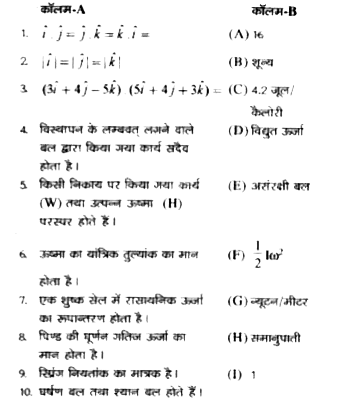सरल रेखीय या एकविमीय प्रत्यास्थ टक्कर के लिए
असत्य
Topper's Solved these Questions
- कार्य ऊर्जा और शक्ति BOOK - SANJEEV PUBLICATIONCHAPTER - कार्य ऊर्जा और शक्ति EXERCISE - अन्य महत्वपूर्ण कीजिये ( कॉलम से कॉलम का सही मिलान कीजिये )
1 Videos
- कार्य ऊर्जा और शक्ति BOOK - SANJEEV PUBLICATIONCHAPTER - कार्य ऊर्जा और शक्ति EXERCISE - अन्य महत्वपूर्ण प्रश्न (अतिलघुरात्मक प्रश्न )
40 Videos
- कार्य ऊर्जा और शक्ति BOOK - SANJEEV PUBLICATIONCHAPTER - कार्य ऊर्जा और शक्ति EXERCISE - अन्य महत्वपूर्ण प्रश्न ( रिक्त स्थानों के प्रश्न )
10 Videos
- कणों के निकाय तथा घूर्णी गति BOOK - SANJEEV PUBLICATIONCHAPTER - कणों के निकाय तथा घूर्णी गति EXERCISE - गत वर्षों की विभिन्न प्रतियोगी परीक्षाओं में पूछे गए प्रश्न
30 Videos
- गुरुत्वाकर्षण (Gravitation)BOOK - SANJEEV PUBLICATIONCHAPTER - गुरुत्वाकर्षण (Gravitation)EXERCISE - गत वर्षों की विभिन्न प्रतियोगी परीक्षाओं में पूछे गये प्रश्न
25 Videos
Similar Questions
सही जोड़ें

View Solutionगुरुत्व के विरुद्ध किसी मनुष्य द्वारा किया गया कार्य कितना होगा यदि वह समतल में चल रहा है ?
View Solutionयदि →A और →B दो सदिश राशियाँ है और इनके बीचका कोण θहै , तब →A.→B=………..
View Solutionकिसी एकसमान ठोस शंकु के द्रव्यमान केंद्र की उसके शीर्ष से दूरी z0 हैं । यदि शंकु के आधार की त्रिज्या R तथा शंकु की ऊंचाई h हो तो z0 का मान निम्नांकित में से kiske बराबर होगा -
View Solutionपरस्पर गुरुत्वीय आकर्षण के प्रभाव में दो समान द्रव्यमान कण त्रिज्या Rके वृत्तीय पथ पर गति कर रहे हैं। प्रत्येक कण की चाल होगी
View SolutionFor Un=∫10xn(2−x)ndx;Vn=∫10xn(1−x)ndxn∈N, which of the following statement(s) is/are true? (a)Un=2nVn (b) Un=2−nVn (c)Un=22nVn (d) Vn=2−2nUn
View SolutionIf u_(n)=sin(n theta)sec^(n)theta,v_(n)=cos(n theta)sec^(n)thetan in Nn!=1 then (v_(n)-v_(n-1))/(u_(n-1))+(1)/(n)((u_(n))/(v_(n)))=
View SolutionIf u1 and u2 be the initial velocity and v1 and v2 be the final velocities of the colliding partical then we define coefficient of restitution e as:
e=v1−v2u1−u2
For perfectly inelastic collision 'e' is
View SolutionA particle of mass m moving with velocity u1 collide elastically with another particle of same mass moving with velocity u2 in the same direction. After collision their speeds are v1 and v2 respectively then
(A) u1+v1=v2+u2, (B) u1−v1=v2+u2
View SolutionTwo particles are projected from a point at the same instant with velocities whose horizontal and vertical components are u_(1), v_(1) and u_(2), v_(2) respectively. Prove that the interval between their passing through the other common point of their path is (2(v_(1)u_(2) - v_(2) u_(1)))/(g (u_(1) + u_(2))
View SolutionThe matrices
P[(u1,v1,w1),(u2,v2,w2),(u3,v3w3)]andQ=19⎡⎢⎣22112−5m−815⎤⎥⎦
are such that PQ=l, an identify matrix. Solving the equation ⎡⎢⎣u1v1w1u2v2w2u3v3w3⎤⎥⎦⎡⎢⎣xyz⎤⎥⎦=⎡⎢⎣115⎤⎥⎦, the value of y comes out to be -3, then the value of m is equal to
View SolutionIf nεN and u1=xn,u2=xn−1,u3=xn−2,...,un=x, then u1'.u2'.u3...un'=
View SolutionIf Un=sinnθ⋅secnθ,Vn=cosnθ⋅secnθfor n= 0,1,2,… then Vn−Vn−1+Un−1tanθ =
View SolutionProve that if →u=u1ˆ1ˆi+u2ˆj and →v=v1ˆi+v2ˆj are non - zero vectors, then they are parallel if and only if u1v2−u2v1=0.
View SolutionIf u1,u2 and v1,v2 are the initial and final velocities of two particles before and after collision respectively, then v2−v1u1−u2 is called ___________.
View Solution
